For a greater Loyola | Issue 11 | Loyola



By Lily Bordelon lmbordel@my.loyno.edu
Nicholas Keen and Jessica Valerio were elected as the Student Government Association’s President and Vice President for the 2025-2026 school year after running unopposed.
Keen, a rising senior majoring in Music Industry Studies with minors in Marketing and Business Administration, has been a part of SGA since he joined the First-Year-Council as a freshman before transitioning to Senate for three years.
“It felt like a natural transition. I knew it would be a great way to stay engaged and build relationships,” said Keen.
Since joining Senate, Keen has worked as a Senator at Large for the College of Arts and Sciences and was the Speaker of the Senate his junior year. He has created, co-written, supported, and helped pass over 50 pieces of legislation aimed at benefiting students and improving SGA’s bylaws in these positions.
Keen stated that he plans to focus on building a brighter community by expanding outreach and resources, including prioritizing grants for students that are underfunded by initiating the Brighter Futures Scholarship.
“As a local New Orleanian, I love our surrounding community, and I think we can deepen those connections,” he said.
Keen said he also plans to launch a pass called the SGAccess Pass, which
gives students discounts to local restaurants, and he’s also planning on creating a syllabus bank so students can access course information before classes begin, as well as implementing more grants that will recognize students for their academic achievements.
Keen has many projects he looks forward to working on, including establishing a sustainability fund, supporting the planning of a Lavender Graduation, expanding and securing sponsorships for Iggy’s Cupboard to meet rising student needs, and building a stronger sense of belonging by uplifting current students while welcoming new ones.
“We want to keep Loyola students safe and aware of the resources available to them,” he added. “I also plan to focus on increasing transparency—especially regarding student fees—and making the New Orleans community more accessible to everyone.”
The student body being involved in the decision making process is incredibly important to Keen, and he plans to continue holding open forums where the student body can connect with administrators. He also plans to hold student roundtable discussions where students can address their concerns and be heard.
“Feedback is key! We want to hear what worked this year and what didn’t,” he said.
Throughout his efforts, Keen has de-
veloped an insight to what has made him successful, and he specifies that taking a look at the bigger picture is always important.
“The world can be overwhelming at times. Remember that we’re here to pursue a higher education and grow as individuals,” he said. “Take your time, become the future you want to see, and continue being the compassionate community that makes Loyola so special.”
Vice President Valerio, is also a rising senior majoring in Biology and minoring in Forensic Chemistry. She was also in the First Year Council before serving as Vice President of Loyola’s Chapter of American Chemical Society for the 2023-2024 school year and is currently the Vice President of The National Organization for the professional advancement of Black Chemists and Chemical Engineers.
“Enjoying my experience with student government in high school, I wanted to carry that knowledge to college and help contribute to the Loyola Community,” said Valerio.
While working alongside President Keen, Valerio also aims to advocate for concerns on campus, including DEI and sustainability initiatives.
She also wishes to focus on implementing SGA micro-grants into the community, including programs where students can apply for performance or research grants to obtain the money they
need for either project and to connect with more organizations across campus.
“All of Loyola's Registered Student Organizations have great ideas that often overlap,” she said. “Improving connections across student orgs can increase student engagement and facilitate event planning for those who organize.”
One aspect Valerio said was important to achieving goals was to continue trying new things.
“Loyola is a melting pot of beautiful encounters and great experiences waiting to happen so try new things even when you're scared because more often than not, the outcome is very fulfilling,” she said.
Valerio said she is grateful that Loyola elected her administration and is looking forward to the fall.
“I would like to extend my gratitude to the Loyola Community for their faith in President Elect Nicholas Keen and I to curate a Brighter Loyola!” said Valerio.

ACROSS
1. Be right back, abbr.
4. State with the most national parks
13. Nickname for a large reptile that has a large population in Louisiana
15. Sound a sheep makes
16. Gradually wear away from the elements, in past tense
17. Large falls in upstate New York
19. Psorthspis ______ is a spider hunting wasp from California
20. Overtime, abbr.
21. Take “Ecofeminism eologies” with this professor for a Worldly Religion credit
23. Trump shooed away this big news station from White House meetings
24. Initials for a women philosopher known for her anarchist and feminist ideas
26. Medical term for swelling
27. Baby’s rst word
29. Media player for cross-platform streaming
31. Government agency that oversees U.S. federal elections
32. Estimated Annual Income, abbr.
33. Government agency that supports research in non-medical elds of science
36. International Chiropractors Association, abbr.
37. Killer whale that hate yachts
38. Data set used by the Environmental Protection Agency to measure environmental quality
39. Double negation of “no”
41. Premium paid for exchanging one currency for another
42. Your assignments are ___ at Sunday 11:59PM
43. Air Defense Identi cation Zone, abbr.
44. Ca_____, a group of cows
45. Broke a leg? Go to the __
46. Irish for bed
48. Ilhan ____, U.S. Representative
49. Farmers Market on Friday at the _____ Quad
52. Youngboy, abbr.
53. Short for medical
54. Season after spring
55. Country code for Chile
57. Lovey name
58. River in Russia
59. Alternative spelling for these large birds
61. Ordinary Least Squares, abbr.
62. is is made by honeybees
66. Trump plans to cut funding to this news source
67. e theme of this crossword is…
DOWN
1. Worms to sh
2. Public transit system in New Orleans
3. Type of wetland known for its wet, spongy ground
5. Nature overtakes these kinds of buildings
6. e state we live in!
7. Causal name for a man
8. History that involves telling of stories
9. Weasley character in Harry Potter
10. Sign this document to keep information con dential
11. International Emissions Trading Association, abbr.
12. Humans _______ to nature
13. Place these garden decorations around your home
14. Another name for cool
18. Hebrew for female sheep
19. Math acronym ___DAS
22. Common abbreviation for in other words
24. National park in Florida
25. National park in Montana
27. Southern _________ is one of the largest LGBTQ+ celebrations in the U.S.
28. National park in Maine
30. Greeting or parting in Italy
31. Last week of school is for this type of test
34. Feeling of sickness or disgust
35. Intense aggressiveness
37. Meal of oats
40. Name of the Greenhouse at the top of Monroe
44. Girl that often dresses in boy clothes
47. e idea of destroying our national parks is _____!
49. Less contaminated
50. Toolkit web designers use
51. Initials for New Zealand physicist
54. Spanish for hop in 56. J, K, _, _, _, O, P
60. Government agency that serves to protect the environment
63. Weight watchers, abbr.
64. American Eagle, abbr.
65. Act like a they/them, look like a she/her, smoke like a he/him, party like a __/xyr

For weekly puzzle answers, download e Loyola Maroon Mobile App
Editorial Board
Editor in Chief - Matthew Richards
Managing Editor - Eloise Pickering
News Director - Violet Bucaro
Deputy Campus News Editor - Alana
Frank
Deputy Local News Editor - Mary Ella
Hastings
Worldview Editor - Ecoi Lewis
Life & Times Editors - Lily Bordelon
Dessadra Tezenzo
Sports Editor - Alana ompson
Opinion Editor - Callie Honeycutt
Reviews Editor - Elise Beck
Editorial Writer - Mark Michel
Copy Editor - Kloe Witt
Production
e Wolf Creative Director - Taylor
Falgout
Photo Director - Heidi Herrera-Wanke
Assistant Photo Directors - Sophia Renzi, Ava Dufrene
Chief Illustrator - Daryl Audrey Casas
Distribution Manager - Eloise Pickering, Sophia Renzi
Advertising Coordinator - Emily Keller
Digital & Outreach
Digital Director - Frankie Esteves
Video Director - James Hufnagel
Video Coordinator - Christopher Nesbit
Lead Anchor - Mabel RegaladoHernandez
Social Media Coordinator - Alondra Juarbe
Content Strategist - Andrea Arroyo
Content Strategist & DEIB - Camila Faraudo
UI/UX Coordinator - Daniel Wong
Podcast Anchor - Anna Seriot
PR/Outreach Director - Julia Bueno
PR Manager - Asia Riddle
Crisis Comm Manager - Camila Torres
Contributors
Abigail Schmidt, Alyria Pierre, Anna erapondos, Ashlyn Bobb Collins, Cecilia Calderin, Christopher Pouncy, Dominique Campbell, Eleanor Boucher-Ferry, Gavin Crehan, James Wyrtzen, June Fernandez, Lily Bordelon, Alyvia Pierson, Macee Fielding, Maleigh Crespo, Mark Michel, Morgan Matteson, Myles McWilliams, Natalie Albers, Olivia Sanyal, Samantha Guillotte, Valentina Russell, Lily Haggard, Rodrigo Delgado, Janssen Van De Yacht, Alaina Coleman, Jada Mills, Sophia Santos, Natalie omas, Sky Pele, Deja Magee, Em Bay, Nicholas Gonzales, Anna Seriot, Pharrell Every, Gabrielle Stan eld
Student Media Adviser: Michael Giusti
Assistant Student Media Adviser
Gabriella Killett

CONTACT US
Main O ce - (504) 865 - 3535
Business O ce - (504) 865 - 3536
Adviser’s O ce - (504) 865 - 3295
Correspondence - maroon@loyno.edu
Letters to the Editor - letter@loyno.edu
Advertising - ads@loyno.edu
Website - www.loyolamaroon.com
Twitter - @loyola_maroon
Facebook - e Maroon
Instagram - @loyola_maroon
Our o ce is in the Communications/ Music Complex, Room 328.
Send mail to: e Maroon, Loyola University, Campus Box 64, 6363 St. Charles Ave., New Orleans, LA 70118
e Maroon is published every Friday. Unless otherwise noted, all content is copyrighted by e Maroon. All rights reserved. First copy free to students, faculty, and sta . Every additional copy is $1.00.
e Maroon is printed on 30 percent postconsumer recycled content.

By Valentina Russell varussel@my.loyno.edu
As the spring semester comes to an end, graduation for seniors at Loyola approaches. Marking the end of their journey in college, it also signifies the start of a new chapter.
We were interested in hearing senior's plans for life after college, curious as to what everyone has in store.
Marian Gomez, an international business and marketing double major, was excited about the significance of the moment.
“This moment in my life has always seemed so far away, something I dreamed about but couldn’t exactly picture in my mind,” she said. “Now that it’s here, it feels surreal, but I’m super excited to see what the future holds for me.”
Gomez is considering going to law school to be an immigration attorney.
“I’ve always felt a strong calling to fight for those who are marginalized and be a voice to those who often go unheard,” she said. “This dream has been a driving force in so many of my decisions, and it’s
something I’ve been working toward for most of my life. Helping others is what I truly strive to do with my life.”
Gomez reflected on the first arriving at Loyola. Moving away from everything that was familiar, she had to grow as a person and learn to rely on herself.
”Over time, I found the strength and motivation I didn’t know I had, and I started doing everything in my power to strive for the best for myself in every aspect,” Gomez added.
“I think what worries me right now is the fear that this plan I have won’t work out,” Gomez commented, “How I’m combated is just by trying to set myself up for as much success as I can… understanding if one pathway of my journey meets a dead-end I could always find another.”
Jane Fantaci, another international business and marketing double major, said her goal is to go to California for an internship opportunity and spend more time with her family.
“I’ve definitely gotten some confidence and drive,” she said. “Additionally, a new hatred for group projects.”
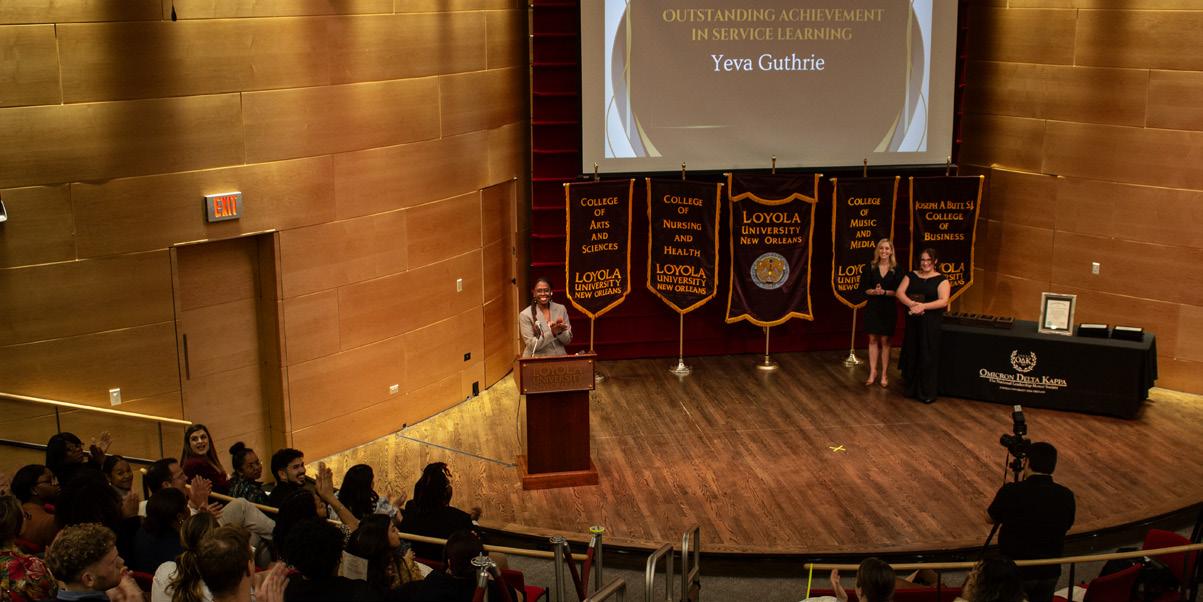
By Alana Frank anfrank@my.loyno.edu
At Loyola’s 45th annual Magis Awards, students, faculty, and staff who go the extra mile were recognized for their outstanding leadership, service, and lasting impact on campus life.
The ceremony was held April 24 in Nunemaker Auditorium, and highlighted the people and programs that help Loyola thrive.
The evening celebrated students across all majors, organizations, and classifications for their leadership, service, and contributions to campus life.
Highlights included:
• Outstanding First Year Student: Kaylee Truong
• Outstanding Sophomore: Paris Hayes
• Outstanding Junior: Katie Buc
• Outstanding Student Program, Event, or Initiative: “Pink Goes Red”
• Student Organization of the Year: Theater for the Culture
• Student Organization Officer of the Year: Mia Bordelon
• Student Employee of the Year: Mia Bordelon
• Fraternity Member of the Year: Conrad Schuster
• Sorority Member of the Year: Madison Benton
• Interfraternity Chapter of the Year:
• CPC Chapter of the Year:: Pi Kappa Phi Gamma Phi Beta
• Mary Ann Reising Flynn Scholarship: Jarriel Dehon
• Outstanding Staff: Lindy Brasher
• Outstanding Faculty: Kendra Reed
• Outstanding Advisor: JJ Marshall
• St. Francis Xavier, S.J. Award for International and Global Perspective: Juan Pablo Tovilla
• Janet Mary Riley Award for the Advancement of Women's Issues: Adriana Sneed
• Rev. Matteo Ricci, S.J. Diversity Award: Gabrielle Stanfield
• Rev. Pedro Arrupe, S.J. Award for Social Justice: Pharrell Every
• Outstanding Achievement in Service Learning: Yeva Guthrie
• Dr. Alton F. Doody Spirit of Leadership Award: Ezekiel Lieberman
• Rev. James Carter, S.J. Award for Outstanding Leadership: Esther Effiong
• Outstanding Contribution to Ministry: Alexander Colby The Magis Awards highlighted the hard work and dedication that define the Loyola community.
Fantaci is worried about some of the unknowns that come with life after school.
“I’m worried about being able to survive on my own,” she said, “Finding housing, a social circle, landing a job that I don't hate. If I could describe my future in one word, it would be kaleidoscope.”
Theater arts and psychology double
"Success looks different for everyone and it’s okay to take detours, redefine your goals as you learn"
Joelitza
Arroyo, Theater Arts senior
major Derek Boudreaux hopes to pursue a masters in counseling. When he reflected back on his time at Loyola, he had some valuable insight that could apply for all undergraduate students.
“When I first got here I was deter-
mined to take every opportunity I could. I wanted to excel in everything. I wanted to be in as many clubs as I could as many plays as I could,” he said.
“Now I understand that I don’t really need to take every opportunity, just the ones I actually want. The ones that are actually fulfilling myself and not those around me”, Boudreaux stated.
“I’m glad I got to meet all the folks that I did. It was cool to see this school transform me into the man I am today. I’m grateful that I had the chance to learn ways not to just improve myself here, but the world as a whole”, he commented.
Boudreaux said that while he has a plan for after graduation, he recognizes that his life can go in different directions.
“I think what worries me right now is the fear that this plan I have won’t work out,” he said. “How I’m combated is just by trying to set myself up for as much success as I can. Also understanding if one pathway of my journey meets a dead-end I could always find another.”
Joelitza Arroyo, a theater arts major, is most looking forward to returning back to her home in Puerto Rico after
graduating. She hopes to work in the arts and publishing industries. “I’m excited to finally apply everything I’ve learned at Loyola University from theatre and design to writing and storytelling, to real-world projects that mean something to me and my community.”
“When I started college, I thought success had a very clear and linear path… Now, I understand that growth is not a straight line. Success looks different for everyone and it’s okay to take detours, redefine your goals as you learn more about yourself,” she said.
Arroyo is preparing herself to balance both her passions and building her career. She’s been working on a portfolio of all her costume designs, poetry, and storytelling to show her skills. “I’m also networking in Puerto Rico and the U.S so I can stay connected to opportunities in both places.”
Arroyo describes her future as hopeful.
Graduation for seniors is Saturday, May 10th, at the Caesars Superdome.
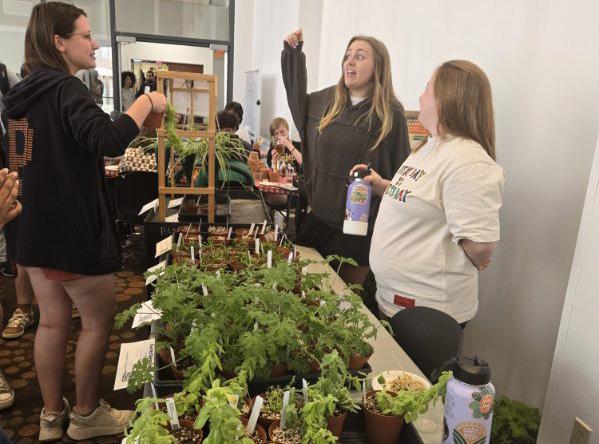

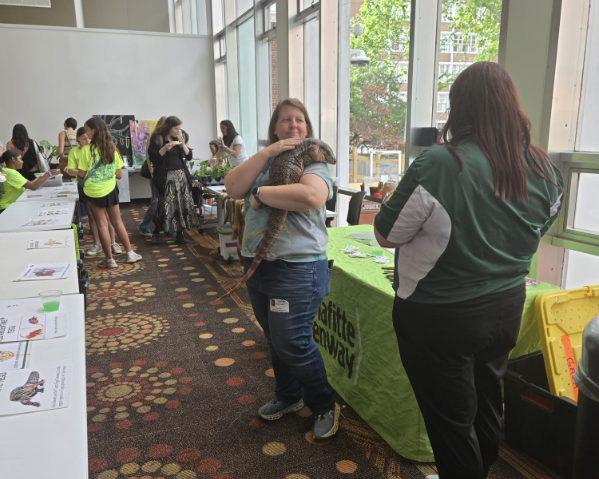
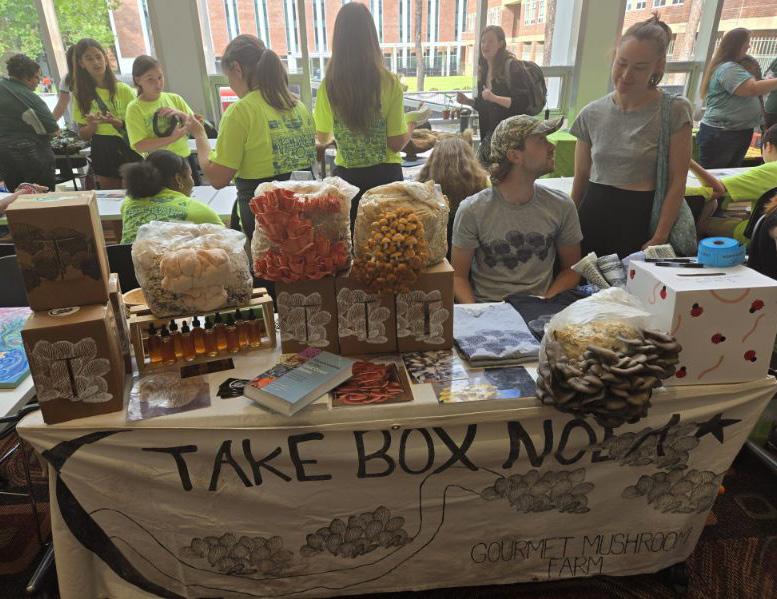
By Kerieyaunta Smith klsmith1@my.loyno.edu
The Environmental Program at Loyola University hosted its annual Earth Week, Our Power, Our Planet from April 22-25. The week started with a mass in the St. Ignatius Temple followed with events like the Environmental Sustainability Fair, a kayaking trip through the swamp, and a campus cleanup walk. The week ended with a farmers market and drum circle in the Peace Quad. The events highlighted Loyola’s commitment not only to the environment but also to community engagement.
By Natalie Thomas nethomas@my.loyno.edu
As the 2024-25 school year comes to a close, students at Loyola University reflect on what they have learned and how they have grown.
Their experiences highlight academic successes, personal growth, and spiritual awakenings, all areas in which Loyola has played a role. Students also expressed gratitude to professors who they said provided invaluable guidance during the academic year.
“My year was fruitful.”
— Ella Yerger Biology sophomore
The past year has represented different things to different students.
"My year was fruitful," said biology sophomore Ella Yerger. Yerger said she had the chance to participate in academic and spiritual activities that helped strengthen her connection to the broader Loyola community.
"The research fair had a big impact on me," Yerger said. "Dr. Allyn Schoeffler helped me a lot this year, both with my research and academic pursuits for the future. I really appreciated all of her help."
Among the most popular aspects of student life this year were campus clubs.
"I participated in a lot of the events they hosted with Wolf Pack Wednesday,” finance freshman Mya Billiot said. “Staying included in things like that made the year more fun."
Student government and Greek life were also often cited as great ways to meet friends and connect with the community.
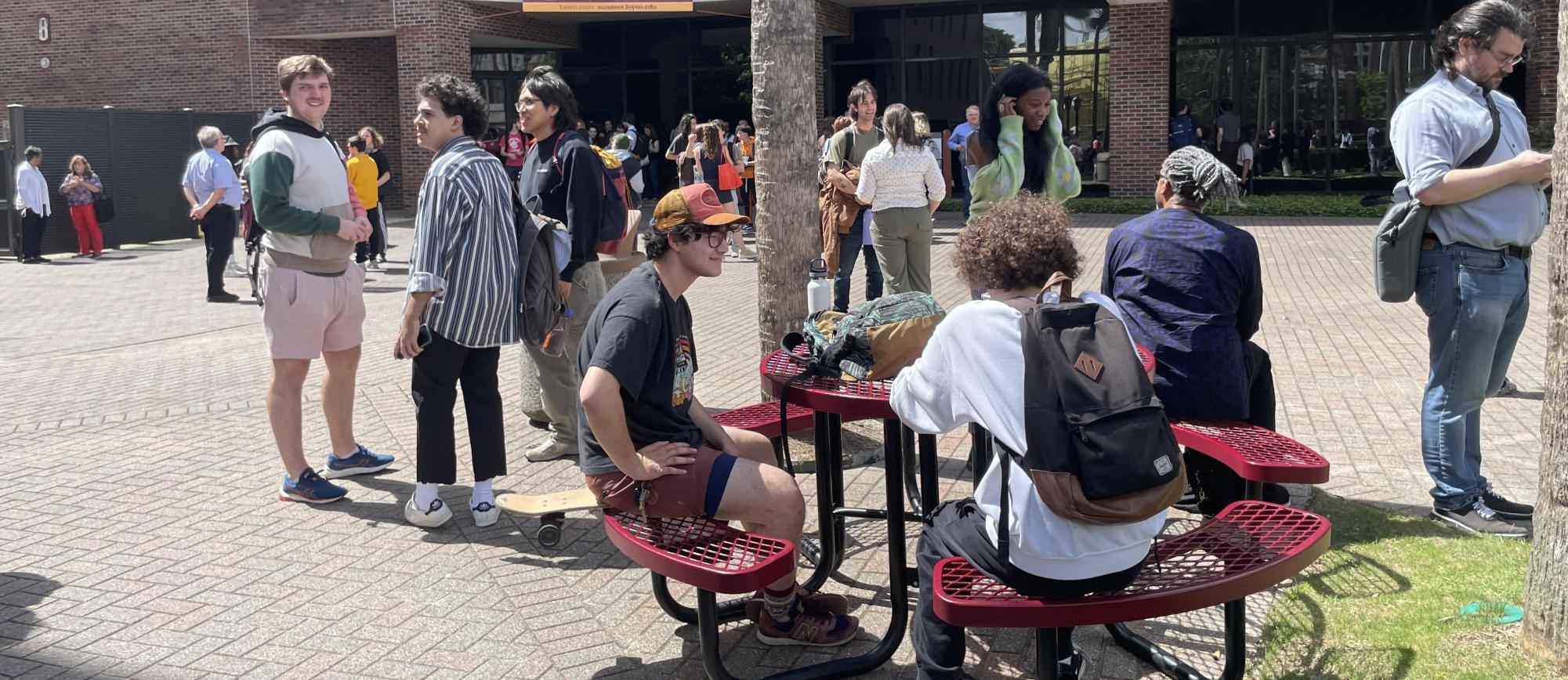
"I am the director of student government in equity and inclusion and also a peer counselor and a member of the Delta Gamma sorority, which has been a great way to meet people,” psychology senior Damari Esqueda said. “These experiences have been transformative for me.
"Spirituality proved to be a driving factor for many students this year, with many finding a sense of community in the church. Holy Name of Jesus Church, located adjacent to Loyola’s campus, became a place for students to gather, engage with others, and deepen their spiritual relationships.
"I started going to the 9 p.m. Mass in January and made a routine out of going to Mass with my friends," Esqueda said. "Doing this really helped me center myself for the upcoming week."
Academics played a major role in students' personal growth over the
ByAlana Frank anfrank@my.loyno.edu
The 2024-25 academic year brought a wide range of events to the Loyola community, from extreme weather and infrastructure challenges to student activism and national attention. As the year comes to a close, the editorial board of The Maroon has compiled a list of top 10 most impactful stories that shaped conversations both on campus and beyond.
These selections reflect not only audience engagement, but also the broader impact and relevance these moments had on the Loyola community.
Here is our list of the top 10 stories of the year, and the reasons why they stood out.
“Live Updates: Campus, Uptown Recover from Hurricane Francine”
When Hurricane Francine hit the New Orleans area, The Maroon provided real time updates to keep the campus informed. Coverage focused on the university’s response, student safety, and
past school year. Many expanded their knowledge through academic fairs and one-on-one mentoring by Loyola professors.
"In the bio department, we did a research fair. My research group presented, and we did a really good job.
“I will miss the friends I have made that are leaving."
Angela Ramirez Herrera Finance sophomore
I felt accomplished," Yerger said.
Students also credited Loyola professors with helping them not only advance academically but also explore and celebrate their cultural identities.
"Dr. Durante Grey was a great example
to me as a Latina writer,” Esqueda said. “I'm a psych and English major, so she helped me dive into that side of my personality."
As the 2024-25 school year concludes, students reflected on some of the things they will miss most from this year.
"I will miss the friends I have made that are leaving," said finance sophomore Angela Ramirez Herrera.
For Esqueda, she’ll miss some of the perks that come with being a college student as her graduation nears.
"I’ll miss living with my roommates and seeing my sorority sisters on campus. I will also miss being carefree as I head into the professional world," Esqueda said.
Yerger offered some advice to the incoming freshmen as they prepare for a new academic semester in the fall.
"Don’t be afraid to try new things," she said.
ByAlana Frank anfrank@my.loyno.edu
The Loyola University New Orleans Alumni Association and the Office of Alumni Engagement are launching the university’s first alumni affinity group, the Black Alumni Society.
The Black Alumni Society was formed organically through social media and communication platforms like GroupMe. After learning that Black alumni were already in active conversation, the university saw the opportunity to formally recognize and support the group.
More than 160 alumni have already responded expressing interest, according to Adria "A.P." Porch, the Director of Alumni Engagement.
BAS is looking to introduce best practices for affinity groups, outline the intended structure, and invite feedback to ensure that the group's goals align with alumni expectations. Participants will also have the opportunity to suggest future programming and events, and share reflections on what they value most about the Loyola alumni community.
Affinity groups at Loyola typically feature their own logos, produce newsletters once or twice a year, and organize one or two events annually. A leadership vote to be held at a later date.
According to Porch, BAS is designed to build community among Loyola alumni with shared experiences, foster mentor-mentee relationships, and strengthen support for current campus initiatives.
“We were made aware of the fact that approximately 400 Black alumni were in communication with one another, and thought the next reasonable step would be to incorporate the group, and have it recognized and supported by Loyola,” she said.
The university hopes to make participation and leadership opportunities within the group as multigenerational and inclusive as possible.
Loyola’s top 10 most impactful stories of the year
the recovery efforts in both Loyola and its surroundings.
“A March to the President’s House”
In a student led protest, participants marched to President Cole’s home to raise awareness about issues including racial equity and administrative transparency. The event caused continued dialogue within the campus community and with university leadership.
“Trump’s Win Shocks Campus”
Following Donald Trump’s election victory, students across campus shared a wide range of responses. This included perspectives from diverse political viewpoints, reflecting the different reactions among the Loyola community.
“Loyola Responds to New Year’s Day Attacks”
The New Orleans Bourbon Street attack on New Year’s Day had a personal impact on many at Loyola. The city’s community responded with memorials, their traditional Second Line dance, and support gatherings to pay tribute to the lives lost that night. Our reporting fo-
cused on the ways students and faculty came together to process and respond to the events.
“Snow Front Page Photos”
A rare snowfall in New Orleans brought excitement to campus. Students and faculty embraced the weather with snowmen, photos, and spontaneous class cancellations. The moment offered a light hearted break from the academic calendar and the usual Louisiana weather conditions.
“Super Bowl Stars: Loyola students shine during Pre-Super Bowl performances”
Several Loyola students participated in performances ahead of the Super Bowl, showcasing their talents on stage. The story highlighted student achievements and the university’s connection to major cultural events.
“Loyola Faces Campus-Wide Hot Water Outage”
A campus wide hot water outage affected residential life heavily and drew attention to infrastructure issues. The
story explored the impacts on daily routines and the university’s response to prolonged maintenance and infrastructure concerns.
“Rally Against the Death Penalty”
Highlighted an organized protest advocating for the abolition of the death penalty in Louisiana and Jessie Hoffman’s execution. Tied to broader discussions about unfair ways to execute human beings and criminal justice reform, the event demonstrated continued student engagement with social justice issues.
“DEI Under Fire: President Cole Addresses Federal Pushback”
As federal pushback and discussions around diversity, equity, and inclusion programs intensified, Loyola administrators issued statements outlining the university’s stance and future plans. It highlighted the local impact of national policies.
“Women’s Tennis Wins First Conference Championship in Program History”
The women’s tennis team made history by winning their first SSAC title in the history of the program in April. The Wolf Pack defeated two of the top 10 teams in the NAIA to accomplish the feat and it capped a record breaking season that saw them achieve their highest ever national ranking (No. 6) and seven All-Conference selections including four of the top 70 players in the NAIA singles rankings in grad student Lucy Carpenter (No. 5), and juniors Micaela Ponce (No. 41), Chloe Henderson (No. 59) and Adele Fereres (No. 69).
So whether students are out marching, bundled up in snow, stuck with cold showers, or watching executive orders pass left and right, this year’s stories captured what it felt like to live, learn, and grow at Loyola during the 2024-2025 school year.

Maroon May 2, 2025

By Violet Bucaro vabucaro@my.loyno.edu
At a recent New Orleans workshop, a circle of public school teachers introduced one another in silence. One mimed playing piano, another swam through the air, and one danced as they demonstrated a new arts-integrated technique for taking attendance.
The training was part of an initiative by KID smART, a New Orleans nonprofit working to expand arts integration in public schools by weaving creative expression into the academic core curriculum. Its mission is to support social-emotional learning and reach public school students through art infused education.
KID smART was founded by Allison Stewart and Hammel Hutchinson who believed there was a need for art in New Orleans public schools. The couple was inspired to make a change after hearing
from a community arts non-profit leader, Bill Strickland. Before Katrina, the organization was an after-school weekend program. Over its 26-year history, KID smART has worked with over 70,000 students and 15,000 teachers throughout New Orleans.
KID smART’s “teaching artists” collaborate alongside academic teachers to integrate visual, theatre, and media arts to the core curriculum. Among the several programs and courses available at KID smART, the Collaborative Artist Residency program matches artists in public schools across New Orleans.
The hope is to integrate the artist's abilities into the classroom over the academic year so that the school teacher can use those techniques long-term after the residency is over.
Education Director Kylee Smith said the program not only benefits students and the education system, but it also
honors artists in professional settings. This shift in the core curriculum sees artists as professionals and educators, according to Smith, and helps teachers not only feel affirmed and supported but also learn tools to practice in their daily teaching.
“It is a beautiful structure that allows the artist and the artform to adapt,” Smith said.
The program’s executive director Elise Goldman said the program gives teachers an opportunity to learn, and artists the opportunity to share.
“One of the things we always think about is the residency program, really being another form of professional learning for teachers,” Goldman said. “The artist is there to bring that art form and that expertise to them.”
KID smART hosts a monthly professional development series called Arts Experience In Classrooms where artists in the creative schools program receive
professional learning around arts integration.
Each resident’s curriculums look different based on the school and the grade level, according to Smith.
“How art looks for a kindergartener should not look how art looks for a 12th grader,” Smith said.
The series branches into small learning groups in science technology engineering and math, arts integration, literacy arts, and social emotional learning seminars where teachers can choose the class they want to attend.
“It's really lovely, teachers describe it as summer camp– we feed them and provide child care for them, to eliminate any barriers,” Smith said. “We are honoring teachers as professionals in that space.”
Zeb Hollins is a KID smART arts integration specialist who teaches Arts Integration 101 at the AXIS series. He said KID smART stands out for its uti-
lization of various art forms with local artists to connect with students. He said his mission is to “demystify” this creative approach to learning.
“What excites me most about KID smART is that it allows their artist to have autonomy in terms of what we’d like to teach within our art form, that isn't really dictated,” Hollins said. “And secondly, the infrastructure that is in place that provides access to the children, that really excites me."
Hollins’ Arts Integration 101 class examines how to teach social and emotional learning through art forms like theatre to serve as a catalyst for learning.
“Imagination is more important than knowledge,” he said.
Social and emotional learning focuses on empathy, managing emotions, establishing positive relationships, and decision making – arts integration does not just focus on art techniques, but on compassion.
Smith said she would trust her own daughter, Naomi, with each of the professional-teaching artists at KID smART.
“I think the best compliment you can give to an educator is, ‘I would trust you with my baby’ and I would not hesitate to put Naomi in front of any one of those nine people,” Smith said.
Arts Integration Specialist Mia Rotondo is an activist educator who works in special-need education. Each week she co-plans with the teacher at the school she works at. When prepping for the end of the year, they created a class dedicated to making invitations to an art show, where students make their own unique invitations with watercolor art.
She takes pride in the work that is done at KID smART, where she said both the children and teachers are given the attention and compassion they deserve.
“We can collaborate and understand what teachers are going through and still be able to work with them and create all these beautiful spaces for every type of learner. I could tell you stories about that all day,” Mia said.
By Macee Feilding' mcfieldi@my.loyno.edu
Loyola University’s Esplanade in the Shade stage spotlighted Loyola music students at the French Quarter Festival.
The festival consists of 20 stages from the Spanish Plaza to the New Orleans Jazz Museum.
The Esplanade stage allowed Loyola students to showcase their talent professionally in front of live audiences. As Hilton Baldridge Chair, Loyola Professor Jonathan McHugh used Hilton funding to collaborate with the French Quarter Festival, offering exposure to performers and students pursuing careers in the music industry.
McHugh has been working behind the scenes at the Esplanade in the Shade stage for the past two years and hopes to continue opening doors for as many interns and paid performers as possible.
“I wish I would’ve had opportunities like this as a student,” noted McHugh.
Popular and Commercial Music sophomore Vienna Notarianni was the first performer on April 13. Although they performed at the French Quarter Festival in 2024 with their ensemble, this was the first time they performed as themself. Notarianni gave a very interactive performance consisting of originals: ‘TYSM’, ‘Where We Disagree’, and a song that recently came out, ‘Why Are You So Ashamed?’
“This is a big deal for me,” Notarianni said.
While they have done some gigs around New Orleans, they hadn’t performed on a festival stage like this. Notarianni’s set brought more than 100 people to the stage, including Loyola students, community members, and even a group of swing dancers.
Popular commercial music sopho-
more Lizette Camarena was another student who took on the Esplanade in the Shade stage as a solo artist after performing with her ensemble in 2024. Camarena noted that Loyola’s program does not necessarily help up-and-coming artists get bookings, but does place these performers on stages they otherwise wouldn’t be on anywhere else.
“As music students we are placed at venues like Tip's and Freret Fest which is cool because those are harder to get to and they make it a lot easier. Stream Cavities on all streaming platforms, and BRUSH YOUR TEETH,” exclaimed Camarena.

By Mary Ella Hastings mlhastin@my.loyno.edu
Lizette Camarena was the star of the show growing up. She stood out by dressing up in costumes to perform for her family and guests.
She never let go of that love of performance, and today, she’s a performer who sings about honesty, vulnerability, and the intimate moments of being a teenage girl. Her EP “Cavities” was released on April 10.
Camerena is a popular commercial music sophomore from the border of San Diego and Tijuana. She said she always wanted to be an artist, but growing up, her parents were not music enthusiasts like her, and it was her brother that exposed her to the music realm.
“Me and my brothers, we all very much found music on our own,” Camerena said. “One of the biggest influences for me growing up was my brother when he started getting into music because he would be on aux. ”
Camarena’s single "Teeth" leads into the chorus with the lyrics, “its unsavory /that i'll let you touch me/ four days to find a new warm hobby/.” Her voice is backed with a sweet slow acoustic melody. These lyrics are just one example of the vulnerability she shares with the audience.
Camerena said she realized she could write her own music when her piano teacher gave her the idea.
“I was like, what do you mean? I didn't know you could just write your own songs,” Camerena said.
Her musical identity was influenced by women and being surrounded by women growing up.
“I very much just have been surrounded by women all the time and I think that very much made me who I am,” she said.
Camerena's sound is personal and allows the listener to peek inside her brain, she said.
“I think everyone is an accumulation of everything they've ever experienced,” she said “And I think my sound is kind of the same, where it's like a combination

of everything I've ever experienced in life,” Camerena said.
She said her music comes from a desire to be honest. She discovered this at her all-girl Catholic high school.
“I had like this one year specifically, where I decided I was gonna be super honest,” Camerena said. “I'm literally just gonna say exactly how I feel about everything.”
She said that leading a Catholic retreat of 15 year olds inspired her to be “an open bleeding heart.” She learned through being vulnerable with others, she was able to be more honest toward herself.
Camerena said singing songs about her personal life is easier than talking about them in conversation and singing is a gateway to connect with herself. Throughout her life, she said she struggled to feel understood and writing helped her understand the complexity of the feminine identity.
“I think when you write, you control the narrative,” she said. “I mean, I'm a teenage girl. Of course I feel misunder-
stood.”
She is able to take control of her story when writing music.
“I get to sit with it and marinate with what I'm thinking and like exactly how I wanna say things, I wanna control the metaphor,” Camerana said.
Camarena released her first single “Clothes” in 2024. Followed by “ROT!” and “Teeth” in 2025 which are part of her first EP.
In the second verse of Teeth, Camarena sings maybe this is stupid/maybe call me crazy/ I can’t have nice things, highlighting how she felt when writing the song.
Camarena said when writing Teeth she was not planning on releasing it.
“So I genuinely was not planning on ever, like letting that song to the light of day,” Camarena said.
The song is about a failed relationship, she said, and how it affected her and her self image.
“The situation itself wasn't even that deep, but everyone around me was acting like it was just like a very normal
thing that was happening and I was like, like this is insane,” she said.
Camarena said the situation allowed her to take a look inward and decide who she wanted to be.
“After that whole situation, I was like I really need to take a step back and really evaluate what I'm doing with my relationships with others,” she said. “Because clearly this isn't working out how I want.”
Camarena said she considers herself a very strong person and this song helped her explore how it feels to not be in control of a situation.
“Admitting that to myself was so heartbreaking,” she said.
She leaned on her writing to analyze how she felt and move forward.
Camarena said she writes all her lyrics on her own but works with others for the musical arrangements.
Sebastian Brown and Izzy Gruner are sophomore popular commercial music majors who have worked with Camarena since their freshman year.
“Her recording sessions felt like
sleepovers. Everyone there was your friend, and we just went all night recording,” Brown said.
Brown said that Camarena's clear vision for her sound is something he respects and helping her achieve it makes him happy.
Gruner had similarly good things to say about working with Camarena.
“I would say working with Lizette is like working with your best friend, in the best way possible. It feels like we get to hang out and get work done all in the same rehearsal,” Gruner said.
Camarena knew who she was from a young age, but being at Loyola has helped her find her voice.
“Her sound has shaped her as a being, and her being has shined through her generously expressive, intimate stories,” said Camarena’s vocal teacher, Mercedes Diamond.
Diamond said Camarena is focused and her hard work is evident in her music.
“Her voice is still and always emerging,” Diamond said. “I have appreciated listening as she learns to master her powers. I hear less of her influences and more of her authenticity each season.”
Camarena has an ability to tell stories through her lyrics, expressing emotions that listeners can empathize with.
“I think what makes me different is what makes everyone different. Everyone has their own unique set of experiences that they bring to the table,” Camarena said.
Diamond agrees that her storytelling makes her unique.
“Her ability to sonify her life experiences, and the free and fiery spirit that fuels her powerful voice,” Diamond said.
Performance isn’t just about being the star of the show for Camarena, performance and storytelling are ways for her to connect to herself and with those around her. She hopes that her music will provide empathy for others, leaving them feeling seen and heard.
“There's that feeling of listening to a song that is so specific and then it hits you and you're like, holy shit I feel that,” Camarena said.
By Lily Bordelon lmbordel@my.loyno.edu
Loyola students in the Theatre and Dance department shined on stage in the annual New Works Fest, showcasing their talents and work three nights in a row.
A total of 10 works were performed this year, all written and directed by students, and students in the TAD department had the opportunity to act out these original works alongside their classmates.
Theatre junior Ava Buckley-Wilson acted in “Ode to Vermin” by Hyacinth Downey, and stage managed "The NICU" by Paloma Mariategui.
“It was really amazing stage managing and working with Paloma as a director as well as seeing her piece come to life,” Buckley-Wilson said. “She and the
cast worked their butts off to create a touching and engaging story!”
For Ode to Vermin, she said the cast made a big difference in making the show work.
“The people involved were truly amazing and made the process feel comfortable and easy despite the heavy themes involved in the show,” she said.
Working on both "Ode to Vermin" and "The NICU" meant that Buckley-Wilson needed to prioritize both at times, especially with the short amount of time.
“Sometimes rehearsals would be on the same days so it allowed me to test out my flexibility and adaptation skills,” said Buckley-Wilson.
Musical theatre sophomoreLaura Thompson acted in "Love and War" by Jenevieve Bolen, Aidan Caliva, and Will Irvine.
Alongside working with other students, Thompson also explained how producers were a huge support system when it came to putting together the performances.
“There was so much fun and laughter and I met and worked with some people I had not known before,” said Thompson.
The festival gave opportunities to students that were more focused on production rather than acting, something that is not necessarily accessible in ordinary circumstances, Thompson said.
“It is fun to see what people have been working on and what hidden gems might come out of this type of event,” she said. “It is also super fun and fascinating to cooperate with your peers in so many different ways.”
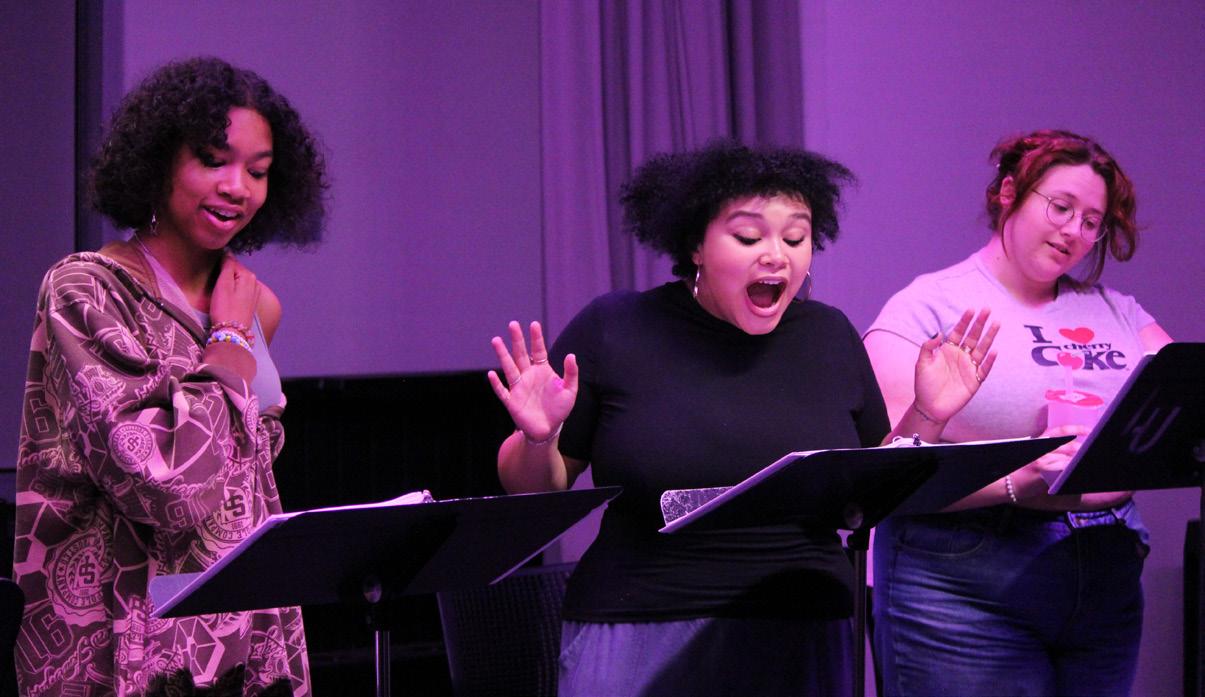

The same personalized support. The same hands-on learning experience. All new possibilities for your career.


Explore versatile programs at Loyola College of Law.

· ·
Juris Doctor – full time, part time, and evening programs
Master of Arts in Environmental Law


Master of Arts in Health Law & Administration ·




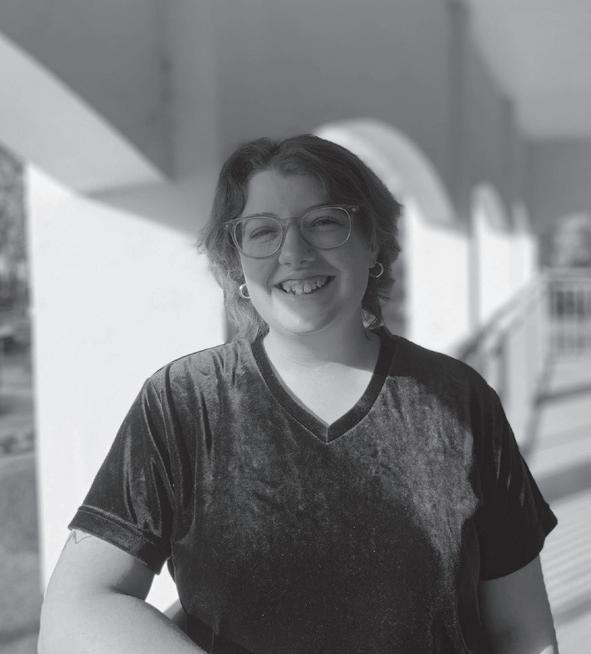
Maggie Lewis Philosophy Pre-Law Major mblewis@my.loyno.edu
Four years ago, I left behind everything I knew and came to Loyola as a bright-eyed,bushy-tailed 18-year-old. Immediately, I fell in love with everything at Loyola and around New Orleans. Everything held a beauty that I had never experienced. From food filled with love and soul to people who act with the kindest hearts, this new experience of beauty pushed me out of my comfort zone and so far forward on my jour-
ney of life. Much of my time at Loyola has consisted of searching for loving friends, amazing new experiences, and a well-rounded academic journey. I’ve discovered these things over time, and although it has required patience and significant effort, I am eternally grateful for every moment at Loyola.
My first opinion piece for The Maroon focused on why leaving your hometown helps you grow, and I still firmly believe that. In many ways, I wish I could go back in time and congratulate my younger self on taking charge of her life and reaching for her goals. That teenage girl took a huge leap of faith, and I am beyond grateful to Loyola for making it all so worthwhile. So, here’s my letter to Loyola - part thank you note, part honest reflection of four years of coming of age in New Orleans.
When reflecting on my college experience, it is only appropriate to start with the things I’ve learned. Not only did I find wisdom in the classroom while reading philosophy texts, I learned valuable life lessons both in and out of the classroom.
From my very first class freshman year— where Professor Josh Hinchie convinced me to join Catholic Studies—my mentors at Loyola have continually pushed me to listen with intention, think with
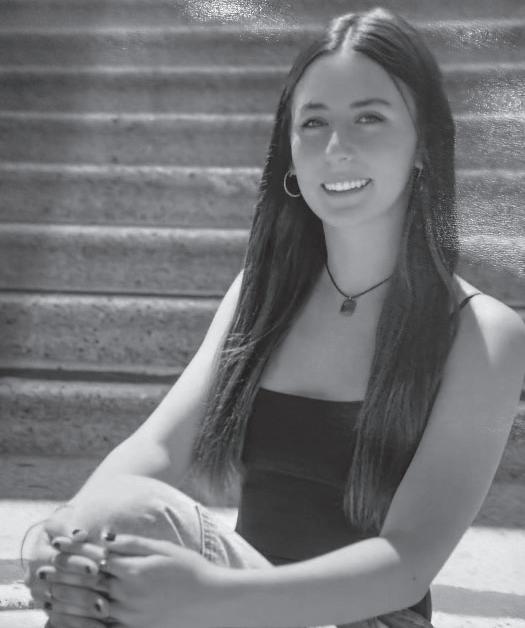
Olivia Sanyal Mass Communications Major ossanyal@my.loyno.edu
This was my spring semester with two separate breaks, Mardi Gras break in March and Easter break in April. In high school I always had a full week off in the middle of April for spring break. I have to say, I like having two breaks. Obviously, for Mardi Gras, people want to stay in town to experience the parades and festive activities all around New Orleans. I know some people who went home halfway through the break and some who stayed the whole time. I stayed in New Orleans throughout the whole break because I didn’t want to miss any of the Mardi Gras festivities, but seeing other people go home did make me miss home a bit.
I'm glad we also have an Easter break because it gives students the opportunity to go home again, which I did this time, back to Santa Cruz, California. It is a pretty short turnaround, though, since after we come back from Easter Break we have about two and a half weeks left of school before exams. It's a four and a half hour flight back to Santa Cruz, which was fine because I missed my family and friends. On the bright side,
we got a pretty good amount of days off where I was able to fly home and fly back and have about five full days with my family and friends at home.
During Easter, I love seeing my little brothers and cousin search around for eggs on Easter morning and my family's brunch. I know I'm not going to be able to go home every Easter, but after moving 32 hours away and not seeing my family for months at a time for the first time ever, it was good to be with my family to celebrate.
"I didn't want to miss the festivities, but seeing other people go did make me miss home a bit."
It was a nice reset before finals. I was also able to pack some stuff up from my dorm and bring it home, making my move-out process that much easier on move-out day. I got to celebrate my 20th birthday on April 21 at home which was relaxing and a good day of seeing friends and family at the beach, in the sunshine. Next year, I'll probably stay on campus for Easter break because it is such a short time off to fly those four and a half hours.
I really enjoy having two breaks with one for Mardi Gras and one for Easter. I think it's split up in a way that has a good balance. Having a break over Mardi Gras allows students to go home if they wish, or stay and enjoy the festivities around the city. Easter break serves as a good way for students to go home before the end of the year without having to go from winter break to summer break if they choose to stay for Mardi Gras.
critical analysis, and act with compassion.
Out of the classroom, I learned things about myself, my faith, and my connection to the world. I found myself in both the quiet moments under the oak trees in Audubon and the wild nights of lights and dancing on Bourbon Street. I saw love in roommates and friends, making me laugh when the rest of the world felt most uncertain. I found community in my job as a Campus Ambassador, showing up as a team to make our beloved school a more welcoming place. I found guidance from my boss, my advisors, my professors, and my peers. Over my four years here at Loyola, I found a home for myself.
More than anything, the city of New Orleans taught me how to have fun in the midst of everyday life. It showed me how to celebrate and smile not only when things are good, but especially when things have never felt lower. I’ll never forget my first Mardi Gras parade—watching a community form around me in the neutral ground while dancing between floats, bonding over a love of king cake. I’ll forever be thankful for the many moments on the streetcar where the city and its people seemed to exhale with me after a long day. Every

typical New Orleans moment’ holds its own sense of beauty and belonging, offering a reminder of why the city is so special.
No words are descriptive enough to truly convey what New Orleans and Loyola mean to me. To the professors and mentors who have believed in me even in the moments that I didn’t - thank you. To the friends who have seen every version of me—confused, proud, tired, joyful—and loved me through all of it - thank you. To the multitude of Loyola community members whose actions
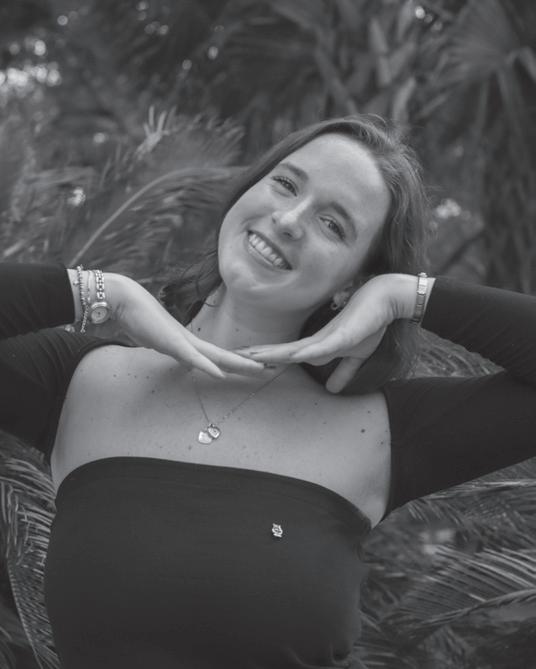
Callie Honeycutt
Mass Communications Major cbhoneyc@my.loyno.edu
Growing up in the South, I have been surrounded by country music for as long as I can remember. Specifically, bluegrass has always stuck out to me. If a song has any sort of banjo component, it will automatically become my favorite.
Therefore, I am a massive Tyler Childers fan. I attended his concert at the Smoothie King Center on April 3, and it was the best night of my life. Childers’ music is a combination of
bluegrass, country, and folk music. He is a simple guy with bright red hair and the smoothest voice. He uses this melodic voice to make you feel like you are standing in the middle of the Appalachian Mountains, with the wind in your hair and the sun setting on nature in front of you, maybe even with a glass of moonshine in your hand.
I have been a Tyler Childers fan since the beginning of high school when I discovered his song “Feathered Indians” and my love for him has only grown. His music reminds me of going to visit my grandma in southern Virginia, playing with my sister in the corn fields, and feeling unending bliss.
Now onto the concert. I went with one of my best friends, who is also an avid Tyler lover, and we had the time of our lives. We sat in the nosebleeds, and it didn’t make any difference or take away from our overall experience.
First of all, he has such an amazing crowd presence. He doesn’t talk too much (which I think can get annoying), but just enough so that you are still hanging on to his every word. He played my top three songs (“All Your’n”, “Space and Time”, and “Way of the Triune God”), which I freaked out and
go largely unnoticed or unappreciated - thank you. To the New Orleans locals who put smiles on my face, yummy meals in my tummy, and hope in my
tersweet. I know I am leaving with so much more than I came here with - new
titude of new connections. I am forever grateful for this city and this school and how it’s raised me the past four yearsnot just into a college graduate, but into a person who lives, loves, and acts with
To my eighteen year old self—you
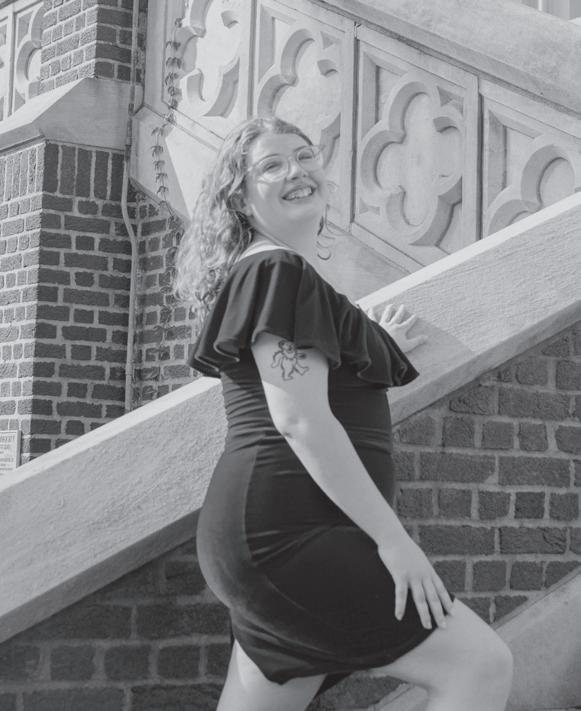
did it. As scared as you are, it’s all worth it. The late nights studying, the heartbreaks, the anxiety of being away from home all came to form a more beautiful experience than you could ever imagine. Thank you, Loyola, for believing in that naive young girl more than she believed in herself. Here’s to many more generations of The Wolf Pack finding hope, wisdom, and courage through this blessed community.
shed a boatload of tears over. I didn’t know every single song he played, but the best part about Tyler is that you don’t have to know his music to enjoy it. You can still get into the moment and the songs without having ever heard them a day in your life.
Childers performed with his seven man band, all playing straight from their souls. He introduces each of his band members extensively, sharing their backstory of how he met them and the memories they have shared. It's an emotional moment that makes you feel like you are on that stage with them. He moved to the middle of the arena to a small circular stage to get closer with the people that were farther away and it made the experience that much better. Then he played my all-time favorite song “Way of the Triune God” and I lost my ever loving mind.
I kind of blacked out after that from adrenaline and excitement, but all I need to say is that if you have the opportunity to go see Tyler Childers live, take it. Embrace his quirky backwoods folk music and don't let the laws of man tell you what you ought to do.
Lily Haggard
Mass Communications Major lahaggar@my.loyno.edu
John Maus is a synth art-pop visionaire with a unique baritone sound. In his performance at Gasa Gasa, Maus was a force from the moment his first song "Bombs Away" began. In addition to singing, he embodied this strange disarray that gives his synth-heavy, dys-
topian music the feeling of someone alternating between a breakdown and a dream. Maus was fist pumping, headbanging like he was at a metal show, and he even punched himself in the head in rhythm with the beat (or, more accurately, out of rhythm, because why not?). Gasa Gasa’s setup is perfect for this kind of intensity. The low ceiling and tight crowd make you feel like
you're part of whatever fever dream he's having. The mid-set slowed down a bit, but he pulled everyone right back in with "Touchdown" and by the time "Pure Rockets" and "Cop Killer" hit, the crowd was just as unhinged as he was. He didn't say goodbye, but threw a fist up, " and honestly, that felt more genuine than any “thanks for coming” ever could.


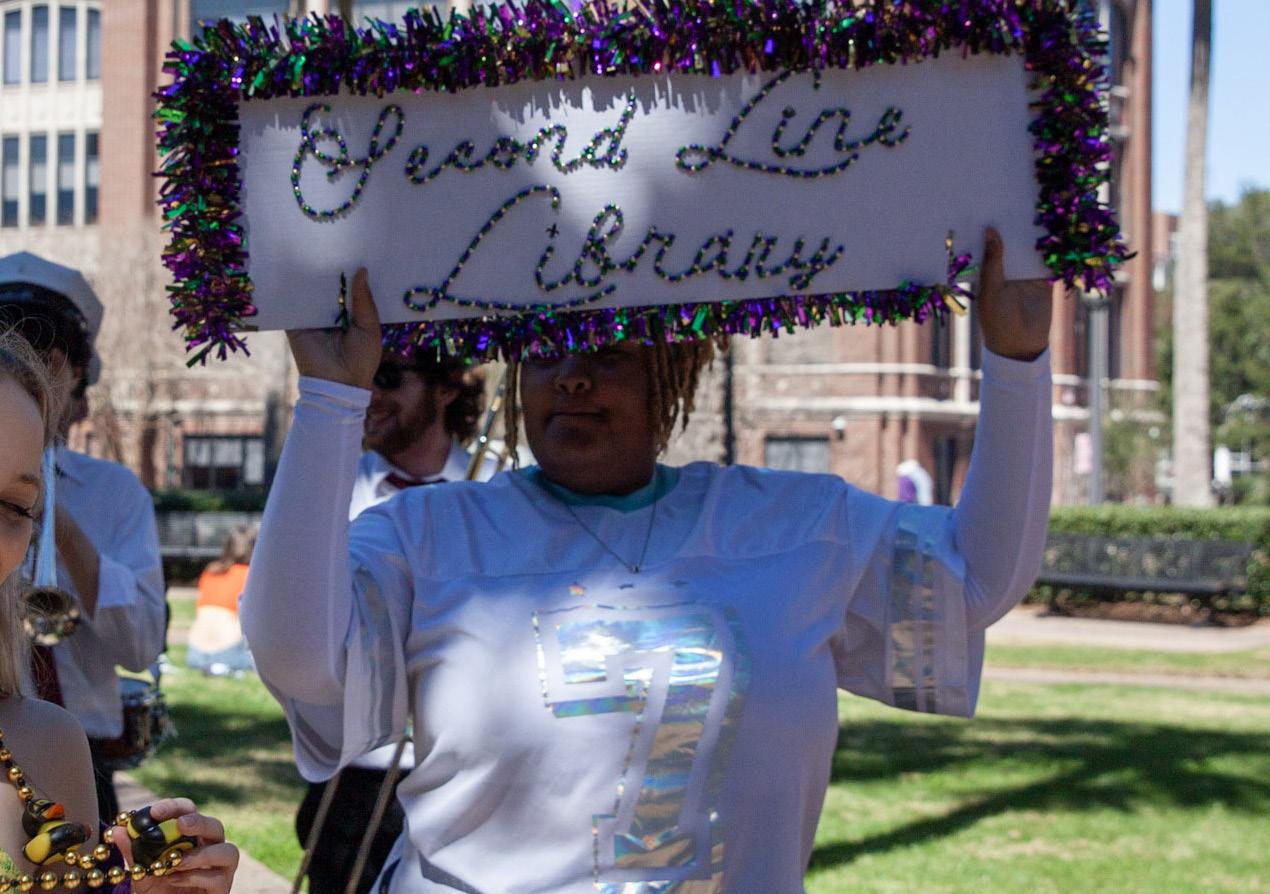


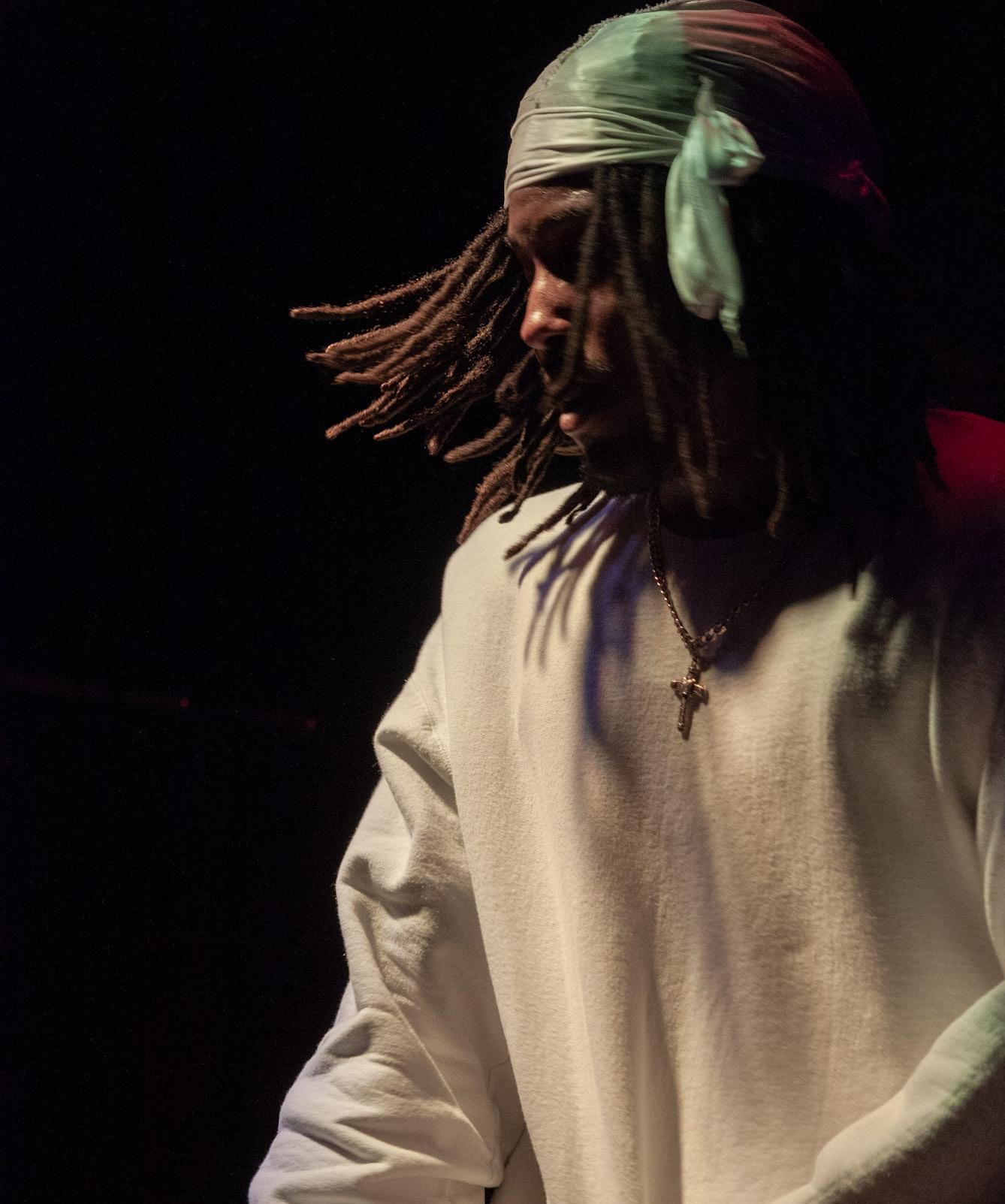
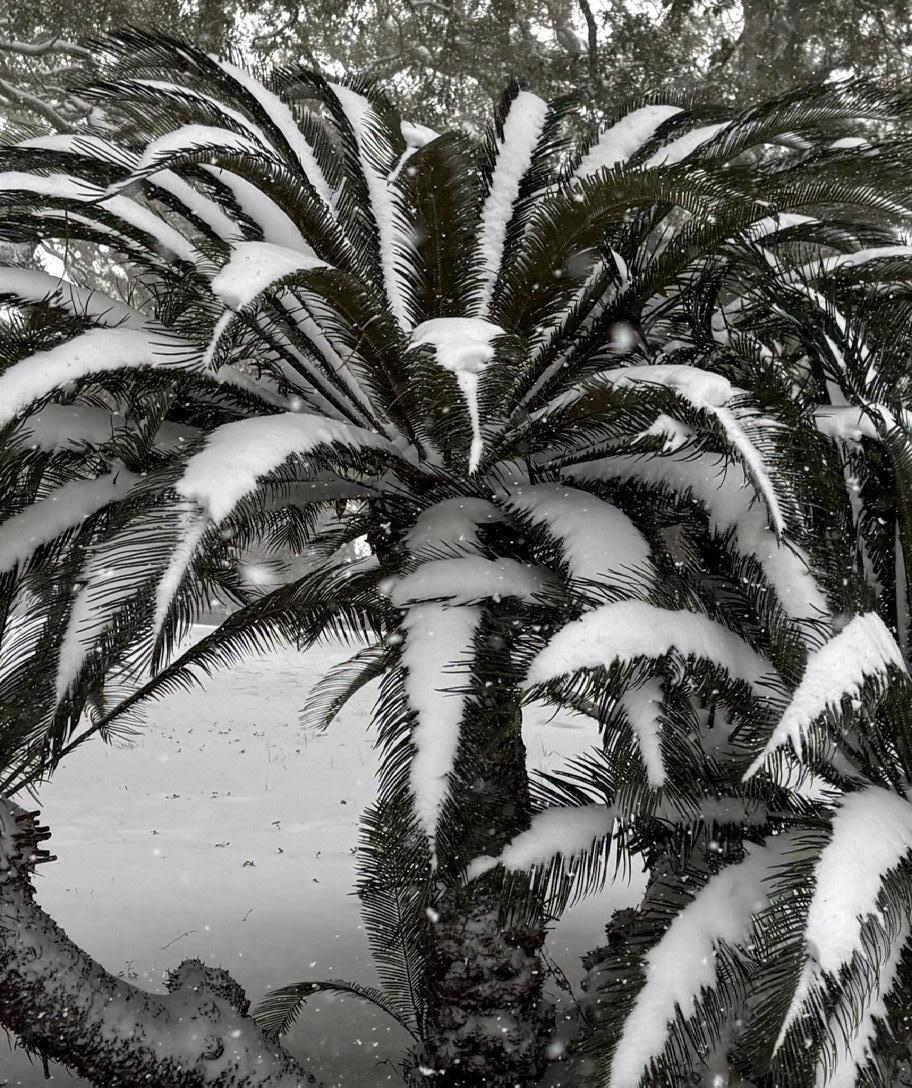


By Alana Thompson anthomps@my.loyno.edu
For the first time in program history, the Loyola women’s tennis team won the Southern States Athletic Conference Championship and will advance to compete for a national title.
Under the leadership of sixth-year head coach Matt Llewellyn, the Wolf Pack had a 16-5 regular season record, going 4-2 in their conference. Llewellyn said he saw the vision for the team winning the conference when he began coaching in December 2019.
“I knew we had a long way to go, but with the right group of people we could eventually do it,” Llewellyn said. “We made the finals two years ago, but looking back we were not ready to win it. We learned a lot and continued to improve as a team and I too as a coach.”
During the Wolf Pack’s conference tournament run, the team defeated two of the top 10 teams in the nation in Middle Georgia State in the semifinals and William Carey in the championship match. This championship was something Llewellyn said means a lot to the team.
“For the team, it's so validating for them to have a trophy that represents everything they have worked for and who they are as a team,” Llewellyn said. “No one can ever take this from them.”
International business junior Adele Fereres was named the tournament MVP and said she couldn’t do it without her teammates.
“Getting that recognition is meaningful, but I couldn’t have done it without my teammates,” Fereres said. “They constantly push me and support me, and I hope I do the same for them.”
The women’s tennis team’s first conference championship not only means a lot to the team but to Loyola as a whole. This historic title displayed the growth
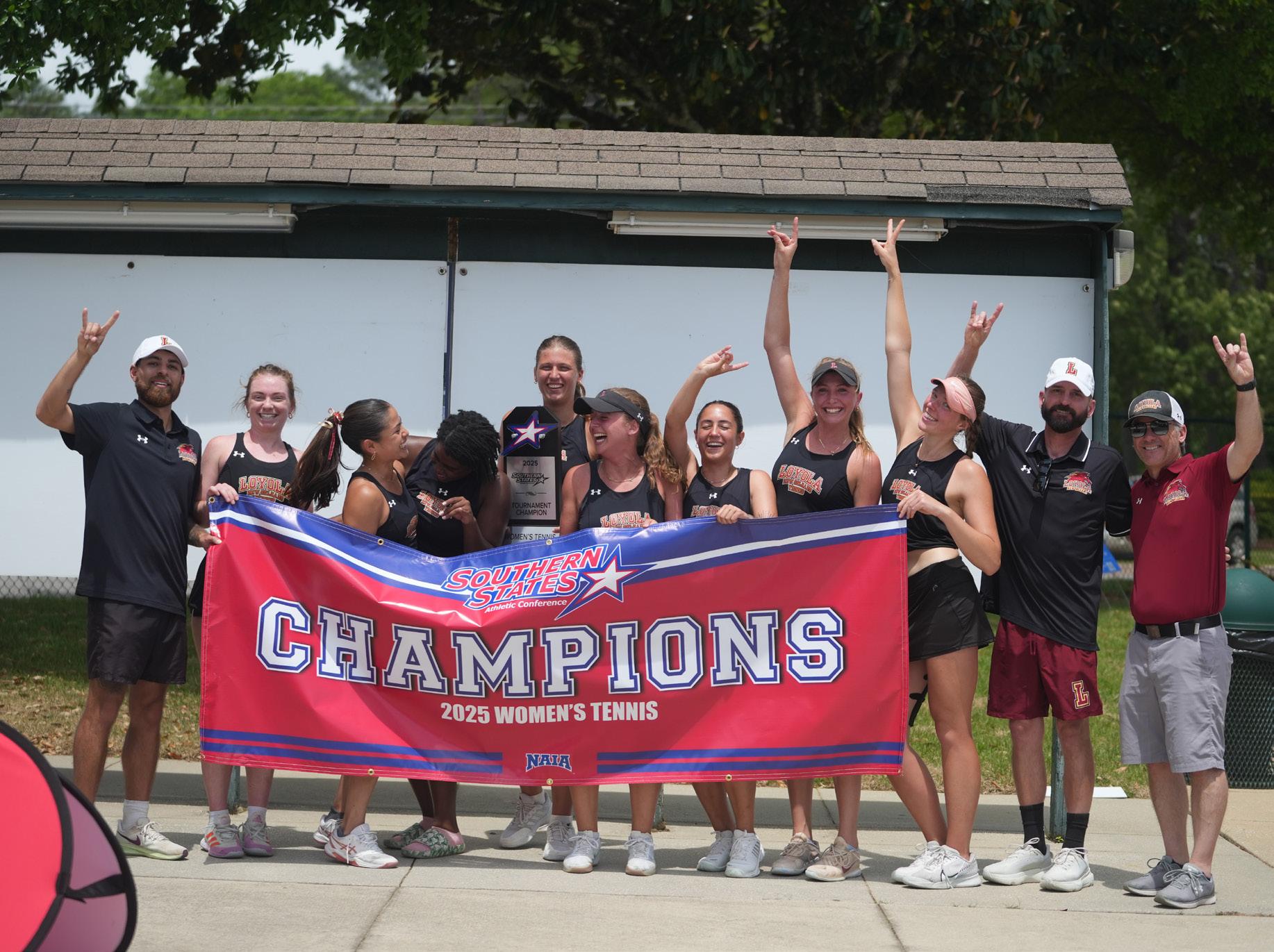
and evolution of the tennis program, according to Llewellyn.
“Loyola women's tennis came from gathering players from other Loyola sports to fill a roster,” Llewellyn said.
“Now, we are the best tennis team in Loyola history. We have been the top nationally ranked and most accomplished team in the athletic department all year. With this title, we will become the first
Loyola women's tennis team to be in the Loyola Hall of Fame.”
This conference championship run felt different for the team, according to Fereres. She said the team’s focus, determination, and strong rapport were the biggest factors that made a difference in the long run.
“Every girl on this team woke up each day with a clear goal in mind, to win,”
By Matthew Richards mlricha2@my.loyno.edu
“It has been my goal to one day be the head coach here since I left the program,” Loyola’s new men’s basketball head coach Trey Lindsey said at his introductory press conference on April 30. Lindsey rejoins the Wolf Pack as the 20th head coach in program history after spending the 2017-18 season as an assistant coach under Stacy Hollowell and playing a role in the recruitment of Zach Wrightsil and Myles Burns, Loyola’s top two scorers in program history and fourtime National Association of Intercollegiate Athletics All-Americans.
He takes over a program that is com-
ing off a 12-16 season that missed the national tournament for the first time in seven seasons but returns 13 players from last season’s squad.
“Loyola gave me my first full-time college coaching job,” Lindsey said. “So it’s an honor to be back here to lead this program.”
Lindsey left his previous job as an assistant coach and the director of recruiting under Hollowell at the University of New Orleans and is looking forward to bringing his knowledge and experience to the school.
“Loyola was and is a pretty easy sell for me,” he said. “The people who work here, the coaches, the academic rigor, and location, all make this a pretty special place.”
Assistant Vice President of Athletics Brett Simpson said Lindsey’s hire was one that meant a lot to be able to bring him back to Loyola.
“Thankfully we didn’t need to fire up a jet and fly him out here to get him,” Simpson said. “But he’s been a terrific teammate throughout the process and we’re thrilled to have him here.”
Coach Lindsey has already begun ingratiating himself with his new team through offseason workouts.
“We’ve only had about eight workouts, so I don’t think they’ve gotten used to me yelling yet,” he said. “But give it another month, and they might be sick of me by then.”
Fereres said. “That kind of drive is rare, and it really pushed us to the next level.
On top of that, we have a bond that goes beyond tennis. Coach Matt has done an amazing job recruiting not just strong players, but great people.”
With the SSAC championship title secured, the Wolf Pack began preparing to compete in the National Association of Intercollegiate Athletics National
Championship Tournament in Mobile, Alabama. The team is preparing for the national championship differently, prioritizing “more off time” for their mental and physical recovery.
“I want them to rest up, catch up, celebrate this season together for one week after the SSAC tournament,” Llewellyn said. “Then we'll grind for a couple weeks before nationals.”
The NAIA Tournament begins on May 13. Llewellyn said the team’s mindset is “super confident” and they’re looking forward to competing in Alabama.
“We are 6-0 this spring at Mobile Tennis Center,” Llewellyn said. “It's a fact we play our best tennis there. We can't wait to go back.”
Similar to Llewellyn, Fereres said the team’s belief in themselves is at an “all time high” and want to keep the momentum from winning the SSAC title.
“We’ve proven to each other what we’re capable of, and now we’re putting in the work to carry that momentum into the national tournament,” Fereres said.
With the tournament approaching, Llewellyn said he wants the team to remember “that feeling walking off the courts in Mobile as champions.”
“We'll be the most dangerous team to play at nationals if we can harness that feeling and continue to keep our confidence extremely high,” he said.
The Wolf Pack are set to play the winner out of No. 11 Marian University and No. 22 Concordia University. Fereres said she is looking forward to the energy that the NAIA tournament brings.
“I love the energy of the NAIA tournament,” Fereres said. “Being surrounded by the best teams in the country creates such an exciting atmosphere. For some of our teammates, it’ll be their last college match, and that makes this experience even more meaningful. I can’t wait to see what we accomplish together.”

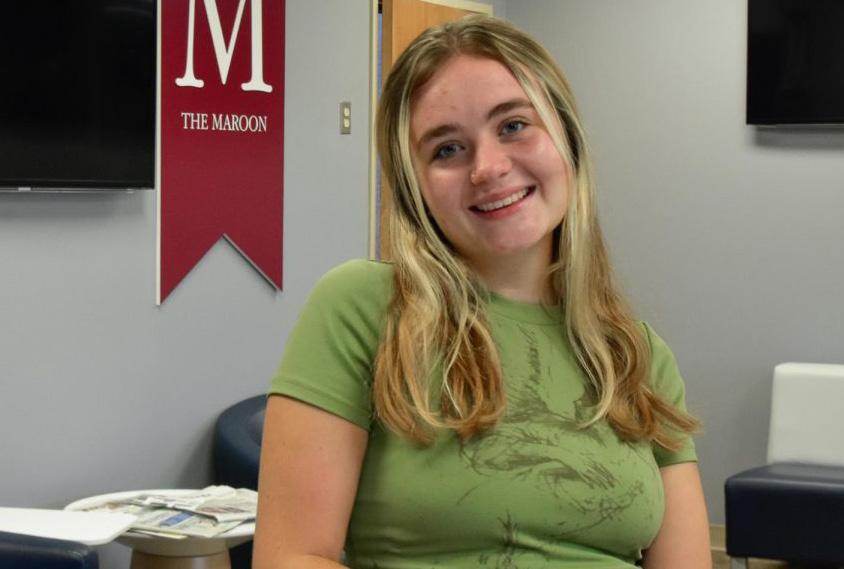
The weekend before classes started my first semester here at Loyola, I went to the third floor of the Communications/Media Complex to visit The Maroon. There were only a couple of people milling about the newsroom, but they filled the space with their warmth. I sat down with Kloe Witt, the campus news editor at the time, while she told me about The Maroon. About a week later, I
became her assistant.
I frequently look back on this moment when Witt took me, a freshman with no experience and little skill, under her wing and brought me into one of the most special places I know. That action and event has always meant the world to me, and I truly believe it exemplifies the nature of The Maroon and all the people in it.
The Maroon has a rich history. The more time I spent with the newsroom, the more grateful I felt to be a part of such a wonderful organization. From researching the first female editor in chief and speaking with her granddaughter to celebrating The Maroon’s 100 year anniversary to spending hours just combing through the archives, I have learned so much about all that this newsroom has accomplished.
I didn’t always think about running for editor in chief. But as I gained more experience and confidence, running for the position felt like the next best step. The idea of leading an organization with as many accomplishments and a reputation such as The Maroon was, and still is, daunting. But with the wonderful and motivated staff we have, I feel confident that together we can take The Maroon into another accomplishing semester.
I have a few main goals for The Maroon as we all begin this next academic year, but proper coverage is one of the most important to me. The Maroon shouldn’t just be a weekly printed issue, but an honest reflection of its motto: The Mirror and The Lamp of Loyola University. I strive to bridge the gap between our organization and the entire Loyola community. First and foremost, that en-
tails ensuring that our coverage reflects the needs and activities of our students. I also hope to expand our digital presence, engaging with our student body in a way that we hear what’s important to them.
We’ve also done exceptional work in advocating for our faculty, reporting on our administration, and covering prominent issues in our community.
In my two years at Loyola, I’ve been a part of and witnessed talented student journalists cover a variety of topics from a major hurricane, a once-in-a-lifetime snowstorm, a 30 hour encampment right next door, student accomplishments, and more.
I have learned immensely from the people and students around me, and the things we have experienced together. My peers have taught me more than I could have ever learned on my own.
Watching them move through their days and working as reporters with grace and confidence has given me the confidence to take this next step in my educational career.
As we move into this next phase of life, I am proud and privileged to not only be a part of The Maroon, but to lead a talented group of students into our next chapter. Thank you to Matthew Richards for gracefully passing me the torch - I have big shoes to fill but he has been a fantastic mentor to me, as well as all the editor in chiefs I have worked under and students I have worked with.
I am beyond excited to be a part of The Maroon for another semester, and I will work every day to uphold the powerful reputation it holds, striving for honesty, consistent growth, and community.
Eloise Pickering
Tales from Spring 2025: A time of firsts, wild stories, and a whole lot of late nights.

I never really set out to be the Editor in Chief of The Maroon. It just kind of happened. I spent two years honing my skills and hanging out in the office in a myriad of roles, and eventually it felt like the only logical move to make next was to try my hand at running the place. And to my surprise, my peers felt like I could and elected me to the position. It was a long way from where I ever thought I’d be when I got here.
I came into Loyola at the tail end of the COVID-19 pandemic, where campus was still somewhat siloed and masks adorned our faces. Just as my college career was getting started, Hurricane Ida came in and changed up everything. For 2 weeks, I found myself stuck in a Houston hotel room wondering what kind of school I would be coming back to as I
and my fellow freshmen tried to find our footing as the newest members of the Wolf Pack. Fast forward to now, in the final semester of my senior year, and I am so grateful for all of the moments and milestones that I’ve gotten the chance to be a part of and cover during my time here at Loyola.
From our first national championship in 77 years, the appointment of our first Black president in school history, the renaming of a dorm, the destruction of Mercy Hall, the construction of the new chapel and a new dorm, the numerous protests, and a Final Four for good measure, my time at Loyola has been something I’ll never forget.
As the Editor in Chief of our award winning publication, it was nerve-wracking to step into a role with more than 100 years of history and try to continue the legacy of all those who came before me (especially as all of their names are listed on a wall outside of the office).
Then I also had the distinction of being the first African-American male ever elected to the position, which added an additional level of status and responsibility to carry the torch for all those who came before me and to set an example for those who come after me. Loyola has
given me so much and through my work and the platform they gave me, I wanted to be able to give a little back.
I think we can all agree this semester has been a crazy one, and for us here at The Maroon, that has certainly been the case as well. Starting with the devastating act of terrorism that occurred in the French Quarter on New Year’s Day, to the inauguration of President Donald Trump, which we had a chance to travel to Washington DC and cover as a newsroom for the first time in our paper’s illustrious history. Then it SNOWED. It snowed in New Orleans, y’all. Like, real snow. We had a record-breaking snowfall that hadn't been seen in this city for over 130 years! January alone felt like a year by itself.
February meant the Super Bowl, Homecoming, Black History Month, and Mardi Gras. For everyone like myself who stays on campus, it also meant the eventual demise of all of our hot water as our central boilers succumbed to old age and wear (nothing quite kills the party like no hot water, right?). We had the chance to tell some wonderful stories about students who were involved in the Super Bowl festivities, shine a light on some Black Excellence at Loyola, and
even got to dedicate our first issue of our magazine, The Wolf, to some of the wonderful things that make Mardi Gras such a special time of year and not just your normal Tuesday.
Then March rolled around and (mercifully for some of us) so did a week off.
But the hot water went on break too and we got word that the legendary Biever Hall was set to close for some (overdue) renovations. Oh the stories I could tell about my freshman year up there. Next up was the story of Jessie Hoffman, who was the first man executed in Louisiana by nitrogen hypoxia. His story allowed us to shine a light on some of the great work being done by the lawyers at the Stuart H. Smith Law Clinic at the law campus dealing with death penalty cases, and it was an honor to be able to share that story with the Loyola community. We closed the month with a spotlight on one of the more underappreciated parts of campus (We love you, Ms. Ruby!), hosting New Orleans Entrepreneurship Week, and paying homage to the first Black student organization on campus.
For April, we partied with the music students at French Quarter Fest and Uptown Threauxdown, debated the pros and cons of on and off campus living,
told of tuition increases and a lack of raises for faculty members, won some awards (because that’s what we do), and showed some love to the queer community on campus as well.
Now, as we publish our final issue for Spring 2025, I hope that we were able to live up to our motto as the mirror and the lamp for the Loyola community this semester. Our school is so unique and it has been an honor to be able to experience it for the past four years and to serve as your Editor in Chief for this most recent semester. Special shout out to all of my fellow members of the Class of 2025, who I know have worked so hard to make it to graduation and will be reveling in the Superdome on our magical day.
As we all find ourselves looking forward to the future, and our new EIC Eloise Pickering takes over for the fall to continue our legacy of great reporting, I hope The Maroon was able to inform, delight, and showcase all of what makes Loyola such a special place.
Matthew Richards, Editor in Chief Spring 2025
Nicholas Gonzales Pre-Law Major nbgonzal@my.loyno.edu
Sunday evening in the French Quarter: the party is over, church lets out, and souls are absolved. On June 24, 1973, the Up Stairs Lounge buzzed with euphoria, in contrast to the city's sleepy mood. In the late afternoon, members of the gay community relax on this summer evening. Many gathered here for religious services with the Metropolitan Community Church, a Los Angeles denomination known for its inclusion of queer congregation. By 8 p.m., the sun disappeared behind the Mississippi, shadows of the Cathedral steeple reigned over the Quarter, and the fluorescent beacon of the Hotel Monteleone sign illuminated the skyline. The patrons of the Up Stairs Lounge gathered, escaping the brutality of the summer night while singing cabaret tunes. Cigarettes piled up in ashtrays, like a graveyard of ash. Mint juleps lingered on lips. Nearly 125 people filled the galleries.
Amid piano jazz, Buddy Rasmussen, behind the bar, heard the buzzer that no-
tified employers that a patron was at the door, and protected patrons from raids. Rasmussen instructed Luther Boggs to open the door. As if the door to Dante’s inferno had unsealed, the scent of cigarettes and stale booze was promptly overrun by the stench of lighter fluid. Flames grasped the shag staircase, catching onto the drapery, and engulfing the interior. As singing morphed into screams, the Up Stairs Lounge was plagued by a scintillating luster. While Rasmussen escorted 20 patrons safely, Boggs succumbed to his third-degree burns weeks later.
In the confusion of the suffocating fumes, MCC Reverend Bill Larson was killed when a plane of glass pinned him to the fate of the inferno. Larson’s charred corpse remained visible in the window for hours after the New Orleans Fire Department extinguished the fire.
Thirty-two people were killed following the devastation of the Up Stairs Lounge. The names of the victims were printed in local newspapers, outing them, convicting the victims. Four bodies were unclaimed because their families were ashamed of having a gay relative and were buried in mass graves at Holt
Cemetery.
After an investigation, the New Orleans Police Department arrested suspect Roger Dale Nunez despite a lack of evidence. Nunez was released a year later and committed suicide shortly after. Although there is only speculation that the attacker's motive was homophobia, the city’s response exhibited homophobia in its handling of the mass murder.
The community failed to recognize the devastation of the mass killing. According to The Historic New Orleans Collection, one officer told a reporter, “This was, after all, a queer bar.” No elected official responded publicly to the fire. Radio commentators humored that the victims’ remains “should be buried in fruit jars."
Archbishop Philip Hannan denied the victims Catholic funerals. In an article for Time Magazine, the current Archbishop of New Orleans, Gregory Aymond, apologized on behalf of the Archdiocese.
While churches refused services, Reverend William P. Richardson at St. George’s on St. Charles hosted a prayer service, receiving criticism from parishioners. MCC founder Reverend Troy Perry traveled from Los Angeles to hold
further services. The Up Stairs Lounge Fire was the deadliest hate crime against LGBTQ+ individuals until the Pulse nightclub massacre in 2016.
In 2003, the same year homosexuality was legalized in the U.S. through the Lawrence v. Texas ruling, a memorial plaque was placed at the site of a tragic fire. Unlike most plaques, it was on the sidewalk. On April 30, the plaque was stolen, leading to the formation of the Up Stairs Lounge Memorial Plaque Replacement Committee.
Former Louisiana resident Genesis Pauly, a dedicated advocate for southern queer organizations, is personally raising funds to replace the plaque. “I wanted to bring more attention,” Pauly explained, “to those who lost their lives and give them the attention they deserved.” Also involved in the campaign to remember the Up Stairs Lounge Fire for 4 years, Pauly has designed and hand-screenprinted t-shirts commemorating the victims, and says they look forward “to the day a new plaque with name corrections and a renewed memory of that night is placed!”
New Orleans police released a video
showing Dannie “Tank” Conner Jr., 40, stealing the plaque, though no motive has been revealed. Conner was arrested in September. Frank Perez, historian for the LGBTQ+ Archives Project of Louisiana, launched an online fundraiser with the Metropolitan Community Church, aiming to raise $20,000 for a replacement plaque to be unveiled on June 24, two days after the attack's anniversary.
“It’s a cliche, but history is doomed to repeat itself,” said Perez. “Those 32 people couldn't imagine how far we have come as a community. It would be disrespectful to their memory if we don’t fight what's coming out of Washington.”
As LGBTQ+ rights are increasingly threatened, the remedy is to remember history and protest. The 1969 Stonewall Riots sparked activism, while the 1973 Up Stairs Lounge Fire highlighted the community's persecution. Queer people and allies must adopt the activism of past movements, like the AIDS protests, as indifference is harming the community; and must remember those who fought and died for LGBTQ+ rights, as all rights are vulnerable to revocation.
2, 2025
Student government, instead of being an independent part of the school which is supposed to answer to and be run by the students, is a puppet of student affairs.
There is no way to mince words about this. SGA, with all its positions and facets, exists under the control of Student Affairs. In this structure, the faculty advisors have too much sway to control dayto-day business.
The American Association of Student Governments has certain qualifications for ensuring student governments nationwide operate in a way that is accountable to the students, and only the students. As our only true representation in the administration, we need to have an organization that not only represents our students but acts as more than a rubber stamp legislature for the school administration and Student Affairs.
SGA, the University Programming Board, and all registered student organizations need to be under a new structure which ensures their independence within the school structure and that the responsibilities and benefits are solely on the students running them.
Student government needs our active voice and participation at the Board
of Trustees and University Senate meetings and the ability to avoid sway from faculty and staff. The University Programming Board needs to be able to be run by the students and for the students, and students, through their student government, should be allowed to decide how RSOs are formed, which are allowed to exist, and plan and hold events.
“ The Student Government Association needs to take responsibility for itself and be accountable for the students.”
The administration shouldn’t be forcing our student organizations to bend to their will because this is our campus more than it is anyone else’s. Participation in SGA needs to increase, and the first step to doing this is the university taking their hands out of the inner workings of student government and allowing for an independent, student-led or-
ganization to form within the university structure, wholly representative of and responsible to the student body.
The Student Government Association needs to, much like actual representative democracy, begin to take responsibility for itself, and be accountable for the students. The funds need to be given back to the students for the purposes of programming events, homecoming week, tote bags, sweatshirts, and all other kinds of things which increase school spirit and make students proud to call Loyola home. And if SGA and Student Affairs clash at times over funding, student organizations, or university programming, that is completely normal, and shows that there is communication going on between the two groups, and that students' interests are being represented in a proper way.
Over the past few years, the consolidation of student government under student affairs has led students to feel like student government doesn’t represent them and is rather just another clique or club that hardly ever lets in new members, and keeps most of itself secretive to outsiders.
Editorial Board
Editor in Chief
Matthew Richards
Managing Editor
Eloise Pickering
News Director
Violet Bucaro
Campus News Editor Alana Frank
Local News Editor
Mary Ella Hastings
Worldview Editor Ecoi Lewis
Sports News Editor Alana Thompson
Life & Times Editors
Lily Bordelon and Dessadra Tezeno
Opinion Editor
Callie Honeycutt
Reviews Editor
Elise Beck
Editorial Writer
Mark Michel
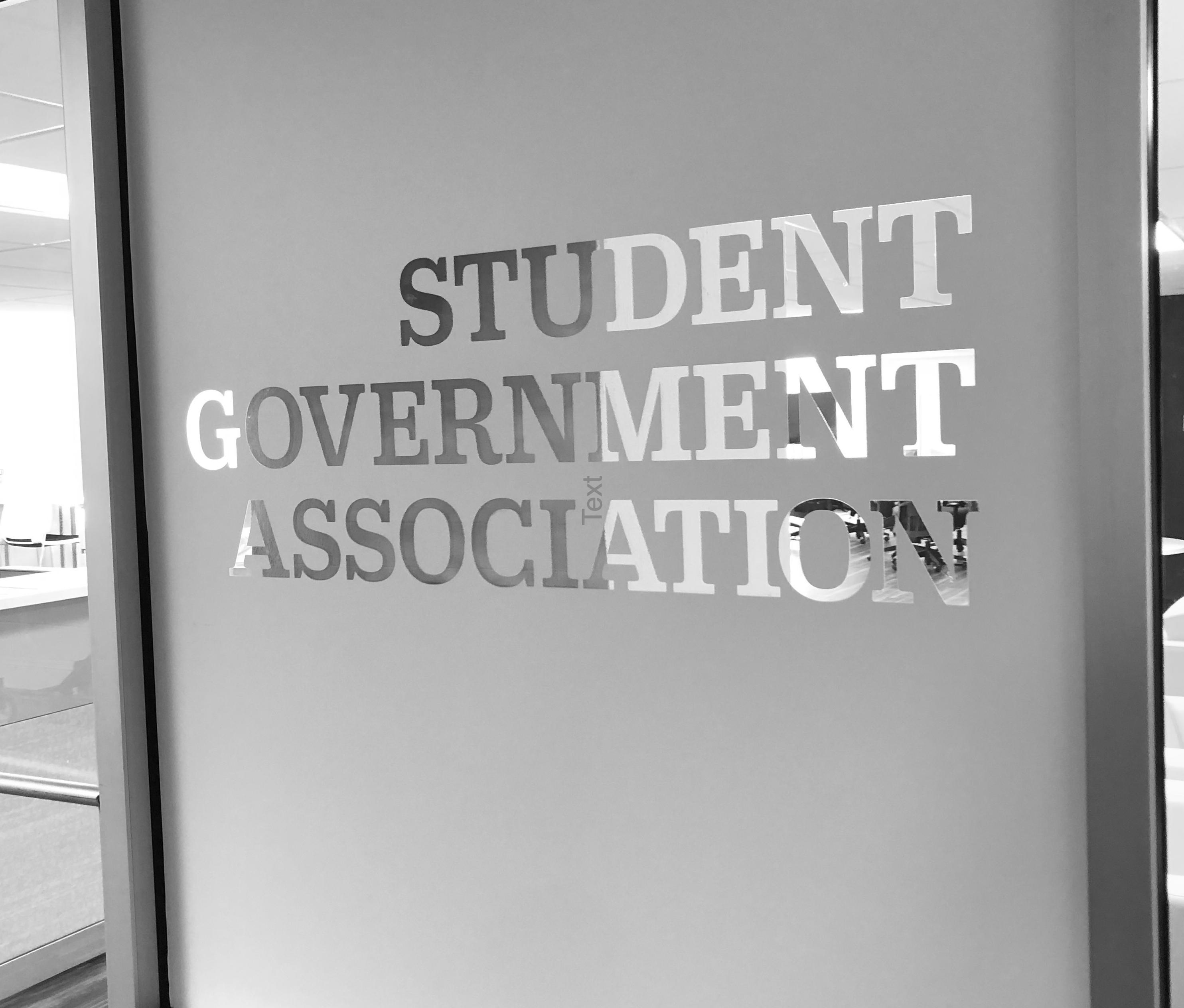
Digital Content Director Francisco Esteves
Photo Director Heidi Herrera-Wanke
The Wolf Creative Director Taylor Falgout
Copy Editor Kloe Witt
HOWL to graduation
GROWL to no AC
HOWL to summer vacation
GROWL to increased tuition
HOWL to faculty raises
GROWL to death of Pope Francis
HOWL to second weekend of Jazz Fest
GROWL to police officers backing into their spots
HOWL to Head Coach Lindsey
The editorial on this page represents the majority opinions of The Maroon’s editorial board and does not necessarily reflect the opinions of Loyola University. Letters and columns reflect the opinions of the authors and not necessarily those of The Maroon’s editorial board.
The Maroon does not represent the opinion of administration, staff and/or faculty members of Loyola.
Letters are subject to editing for length, grammar and style. Please limit submissions to 400 words. Submissions are due no later than 4 p.m. the Sunday before publication.
Please send all submissions —
The Maroon, 6363 St. Charles Ave., Box 64, New Orleans, LA 70118. Email us your letters — letter@ loyno.edu.
Submissions may also be made online at www.loyolamaroon.com.


